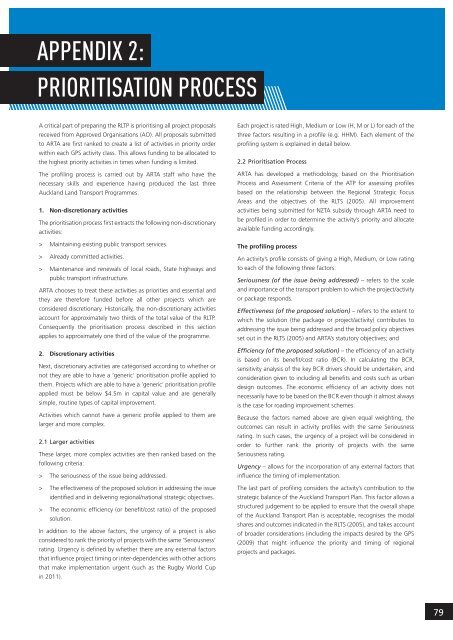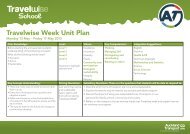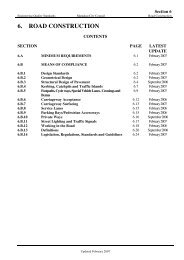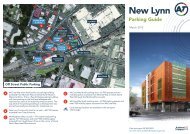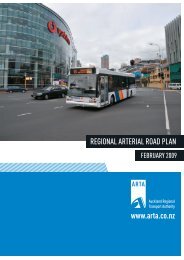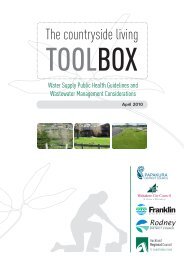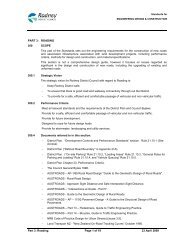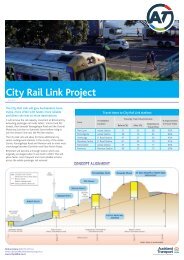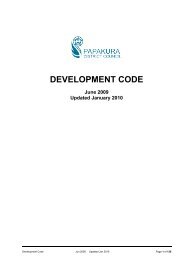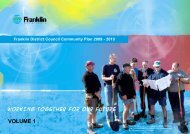Regional Land Transport Programme 2009 - 2010 (2MB) - Auckland ...
Regional Land Transport Programme 2009 - 2010 (2MB) - Auckland ...
Regional Land Transport Programme 2009 - 2010 (2MB) - Auckland ...
Create successful ePaper yourself
Turn your PDF publications into a flip-book with our unique Google optimized e-Paper software.
APPENDIX 2:<br />
PRIORITISATION PROCESS<br />
A critical part of preparing the RLTP is prioritising all project proposals<br />
received from Approved Organisations (AO). All proposals submitted<br />
to ARTA are first ranked to create a list of activities in priority order<br />
within each GPS activity class. This allows funding to be allocated to<br />
the highest priority activities in times when funding is limited.<br />
The profiling process is carried out by ARTA staff who have the<br />
necessary skills and experience having produced the last three<br />
<strong>Auckland</strong> <strong>Land</strong> <strong>Transport</strong> <strong>Programme</strong>s.<br />
1. Non-discretionary activities<br />
The prioritisation process first extracts the following non-discretionary<br />
activities:<br />
> Maintaining existing public transport services.<br />
> Already committed activities.<br />
> Maintenance and renewals of local roads, State highways and<br />
public transport infrastructure.<br />
ARTA chooses to treat these activities as priorities and essential and<br />
they are therefore funded before all other projects which are<br />
considered discretionary. Historically, the non-discretionary activities<br />
account for approximately two thirds of the total value of the RLTP.<br />
Consequently the prioritisation process described in this section<br />
applies to approximately one third of the value of the programme.<br />
2. Discretionary activities<br />
Next, discretionary activities are categorised according to whether or<br />
not they are able to have a ’generic‘ prioritisation profile applied to<br />
them. Projects which are able to have a ’generic‘ prioritisation profile<br />
applied must be below $4.5m in capital value and are generally<br />
simple, routine types of capital improvement.<br />
Activities which cannot have a generic profile applied to them are<br />
larger and more complex.<br />
2.1 Larger activities<br />
These larger, more complex activities are then ranked based on the<br />
following criteria:<br />
> The seriousness of the issue being addressed.<br />
> The effectiveness of the proposed solution in addressing the issue<br />
identified and in delivering regional/national strategic objectives.<br />
> The economic efficiency (or benefit/cost ratio) of the proposed<br />
solution.<br />
In addition to the above factors, the urgency of a project is also<br />
considered to rank the priority of projects with the same ’Seriousness‘<br />
rating. Urgency is defined by whether there are any external factors<br />
that influence project timing or inter-dependencies with other actions<br />
that make implementation urgent (such as the Rugby World Cup<br />
in 2011).<br />
Each project is rated High, Medium or Low (H, M or L) for each of the<br />
three factors resulting in a profile (e.g. HHM). Each element of the<br />
profiling system is explained in detail below.<br />
2.2 Prioritisation Process<br />
ARTA has developed a methodology, based on the Prioritisation<br />
Process and Assessment Criteria of the ATP for assessing profiles<br />
based on the relationship between the <strong>Regional</strong> Strategic Focus<br />
Areas and the objectives of the RLTS (2005). All improvement<br />
activities being submitted for NZTA subsidy through ARTA need to<br />
be profiled in order to determine the activity’s priority and allocate<br />
available funding accordingly.<br />
The profiling process<br />
An activity’s profile consists of giving a High, Medium, or Low rating<br />
to each of the following three factors:<br />
Seriousness (of the issue being addressed) – refers to the scale<br />
and importance of the transport problem to which the project/activity<br />
or package responds.<br />
Effectiveness (of the proposed solution) – refers to the extent to<br />
which the solution (the package or project/activity) contributes to<br />
addressing the issue being addressed and the broad policy objectives<br />
set out in the RLTS (2005) and ARTA’s statutory objectives; and<br />
Efficiency (of the proposed solution) – the efficiency of an activity<br />
is based on its benefit/cost ratio (BCR). In calculating the BCR,<br />
sensitivity analysis of the key BCR drivers should be undertaken, and<br />
consideration given to including all benefits and costs such as urban<br />
design outcomes. The economic efficiency of an activity does not<br />
necessarily have to be based on the BCR even though it almost always<br />
is the case for roading improvement schemes.<br />
Because the factors named above are given equal weighting, the<br />
outcomes can result in activity profiles with the same Seriousness<br />
rating. In such cases, the urgency of a project will be considered in<br />
order to further rank the priority of projects with the same<br />
Seriousness rating.<br />
Urgency – allows for the incorporation of any external factors that<br />
influence the timing of implementation.<br />
The last part of profiling considers the activity’s contribution to the<br />
strategic balance of the <strong>Auckland</strong> <strong>Transport</strong> Plan. This factor allows a<br />
structured judgement to be applied to ensure that the overall shape<br />
of the <strong>Auckland</strong> <strong>Transport</strong> Plan is acceptable, recognises the modal<br />
shares and outcomes indicated in the RLTS (2005), and takes account<br />
of broader considerations (including the impacts desired by the GPS<br />
(<strong>2009</strong>) that might influence the priority and timing of regional<br />
projects and packages.<br />
79


